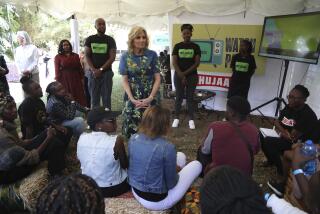U.S. Aid for Illiterate Women Outlined
- Share via
COPENHAGEN — In a speech commemorating International Women’s Day, First Lady Hillary Rodham Clinton unveiled some details of a new, $100-million U.S. initiative to promote literacy among girls in Africa, Asia and Latin America.
The plan was the first concrete measure announced at the U.N. World Summit for Social Development, a huge anti-poverty gathering here this week.
Most of the summit discussions so far have involved general principles and compromises, rather than specific programs and dollars, as rich and poor countries have struggled to agree on a formal resolution on the best ways to alleviate poverty.
Mrs. Clinton’s plan calls for a share of existing U.S. education-assistance funds, now channeled through the U.S. Agency for International Development, to be redirected by USAID into measures to educate girls. The First Lady said about $10 million per year would be spent in the next 10 years on projects meant to increase women’s literacy in target countries by 20%.
“No single factor contributes to the long-term health and prosperity of a developing nation or any nation more than investing in education for girls and women,” said Mrs. Clinton. “In countries where governments have invested in primary and secondary schooling for girls and women, the investment has been repaid many times, through higher economic productivity, greater participation of women in the modern labor sector, lower infant and maternal mortality rates, improved child nutrition and family health, longer life expectancy, lower birthrates, and stronger families and communities.”
Even as she was announcing the aid redeployment before a special International Women’s Day session of the summit, the U.N. Development Program was releasing statistics that suggest women in the world’s poorest countries had little to celebrate on their official holiday.
According to the agency’s newest Human Development Report, more than 70% of those living in absolute poverty in the world are female; two-thirds of the world’s illiterates are women. The report also asserts that 100 million women who ought to be alive today lost their lives to female infanticide, unnecessarily high infant mortality or nutritional neglect of girls.
Again and again over the course of International Women’s Day, summit speakers expressed their conviction that the human race can’t reach its full potential as long as half its members are treated unfairly.
But there was far more goodwill in the air than concrete new suggestions or offers of more aid.
“Our money has got to be catalytic, because there’s so little of it and so much to be done,” said USAID Deputy Administrator Carol Lancaster.
Lancaster said USAID spends about $115 million a year on general education assistance and that the $10 million a year for girls will be taken from that.
Elsewhere at the summit, women marked International Women’s Day with more radical feminist and anti-poverty gestures, including a hunger strike in the summit center’s central hall and a march through the streets of Copenhagen.
More to Read
Sign up for Essential California
The most important California stories and recommendations in your inbox every morning.
You may occasionally receive promotional content from the Los Angeles Times.













